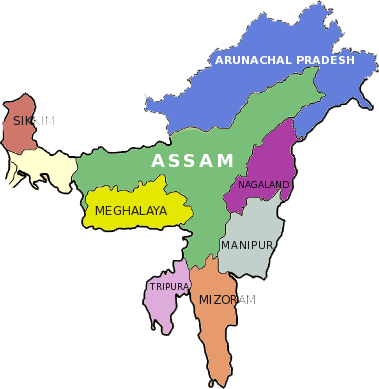National Innovation on Climate Resilient Agriculture(NICRA)
National Innovations on Climate Resilient Agriculture (NICRA) is a network project of the Indian Council of Agricultural Research (ICAR) launched in February, 2011. The project aims to enhance resilience of Indian agriculture to climate change and climate vulnerability through strategic research and technology demonstration. The project was formally launched by the Hon'ble Union Minister for Agriculture & Food Processing Industries Shri Sharad Pawarji on 2nd February 2011.
During the year 2011 to 2015, there were 17 numbers of KVKs representing different agro-climatic conditions with designated problem areas were distributed in the 8 North East States and in the year 2015-16, Six new NICRA KVKs were included in the Six districts of North East. viz., KVK Karbi Anglong in Assam , KVK Ukhrul in Manipur, KVK Jaintia Hills in Meghalaya, KVK Serchhip in Mizoram, KVK Mon in Nagaland and KVK Dhalai in Tripura and altogether a total numbers of 23 KVKs were under NICRA Project. At present, there are 14 KVKs under ATARI, Zone-VII, Umiam (Barapani) as presented in Table 1.
Table 1: State wise details of NICRA KVKs along with their climate vulnerability
| State | District | Village Name | Agro-climate | Vulnerability |
|---|---|---|---|---|
| Manipur | Senapati | Hengbung & Hengbung-I | Sub Trop Plain Zone | Drought/water stress |
| Imphal East | Chingtha | Mild Tropical Hill Zone | ||
| Ukhrul | Ramva | Sub Tropical Hill Zone | Frost/ Soil Erosion | |
| Mizoram | Lunglei | Hnathial | Sub Tropical Hill Zone | Water stress |
| Serchipp | N.Vanlaiphai | Mid Tropical Plain Zone | Drought | |
| Meghalaya | Ri-bhoi | Kyrdem | Mid Tropical Hill Zone | Drought/water stress |
| West Garo Hills | Marapara, Sananggre, Rongbokgre | Sub Tropical Hill Zone | ||
| Jaintia Hills | Umjalasiaw | Sub Tropical Hill Zone | Drought/ Flood | |
| Nagaland | Phek | Thipuzumi | High hill Zone | Drought/water stress |
| Dimapur | Dhansiripar | Mid Tropical Plain Zone | ||
| Mokokchung | Aliba | Mild Hill Zone | ||
| Mon | Ngangching | Upper Brahmaputra Valley Zone | Drought/ Soil erosion | |
| Tripura | Dhalai | Methirmia | Mid Tropical Plain Zone | Flood/ Soil erosion |
| Khowai(West Tripura) | North Pulinpur ADC village | Mid Tropical Plain Zone | Drought like situation |
Module-wise interventions under Technology Demonstration component
I. Natural resource management
A number of interventions were made in the NICRA villages during 2016-17 as climate resilient practices. In-situ moisture conservation were practiced with mulch-plastic, biological waste etc and Raised bed planters in Field Pea, Bitter gourd, Cabbage, Cauliflower ,Tomato, Ginger and Turmeric to conserve soil moisture, reduce evapo-transpiration loss and improve soil health and ultimately higher yield. This activity benefitted 249 numbers of farmers and covered 48.25 ha of land. Improved drainage in flood prone areas with Drainage Channel and ring bund reduced crop damage due to water logging leading to better yield. Conservation tillage was conducted with No Tillage practices, Minimum tillage and Zero tillage in Lentil, Vegetable Pea, Field Pea, Rapeseed, Yellow Sarson. This activity benefitted 150 numbers of farmers and covered 59.7 ha of land. Water saving irrigation methods with water pump set, diversion channel, sprinkler irrigation and drip irrigation benefited 71 numbers of farmers and covered 15.4 ha of land.
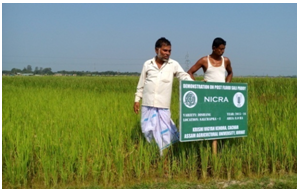 |
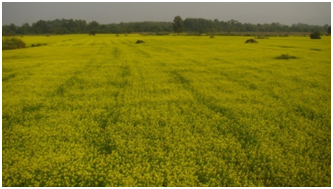 |
| Demonstration of Short duration rice variety 'Dishang' | Demonstration of Late sown Toria in Rice-Toria sequence |
II. Crop Production
A no. of climate resilient crop varieties were introduced in different NICRA villages of the region during the period under report. Flood tolerant varieties of paddy (Bahadur sub-1, Dipholu, Gitesh, Jalashree, Jakunwari, Panindra, Padumoni & Swarna sub-1) and drought tolerant varieties of paddy (Dehangi & Gitesh) were demonstrated in the farmer's field. Likewise, short duration paddy varieties (Dishang, Luit & Kolong), quality protein rich maize varieties (HQPM-1 & RCM 1-3) were also introduced. Introduction of water saving paddy cultivation methods (SRI, aerobic, direct seeding) with different paddy varieties (CAU-R1, IR-36,, Lalat, RC Maniphou-10, Ranjit , RCM 10, SARS- 6 & Sawarna Mashuri) benefited 206 numbers of farmers having the coverage of 73.9ha of land. Location specific cropping sequences of Maize -Blackgram, Maize - French bean, Cabbage - Pea, Maize - Cowpea were introduced benefitting 191 numbers of farmers with an area of 15.72 ha of land.
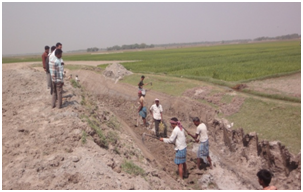 |
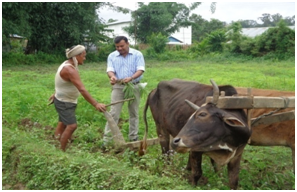 |
| Construction of Drainage Channel in flood prone areas | Growing of Dhaincha and incorporation before rice transplanting |
III. Livestock and Fisheries module
Community lands for fodder production during droughts / floods were used for cultivation of green fodder like Oat (HJ 114 & Kent); Sorghum (Co. F.S. 29); Congo Signal & Maize (African Tall) benefiting 149 numbers of farmers. Improved fodder/feed storage methods with Mineral mixture, dewormer and disinfectant solution were introduced in some of the selected NICRA villages that benefited 91 numbers of farmers having 161 numbers of livestock. Vaccination of cattle against FMD, Pig against Swine fever, poultry against Ranikhet disease were demonstrated among 482 numbers of farmers benefiting 1291 Number of livestock. Improved shelters for reducing heat stress were also 56 locations of the region. Improved breeds of Poultry (Vanaraja, kamrupa Gramapriya & Kuroiler), Piggery (Hampshire); Goatery (Beetal), Duckery (Chara-Chemballi & Muscovy) were introduced in no. of villages benefiting 314 numbers of farmers.
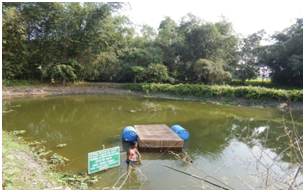 |
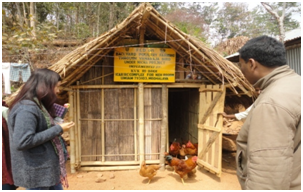 |
| Rearing of fishes in cages in flood affected | Backyard Poultry Farming system unit |
IV. Institutional Interventions
Seed production programme of specific varieties of Rice (CAU-R1, Gitesh, Joymati, Swarna sub 1), Maize (HQPM-1), Toria (TS 36) and Pea (Prakash, WBL-77) was taken up in participatory mode by involving 44 numbers of farmers in 25.6 ha area. Interventions on Custom hiring centre benefitted 510 numbers of farmers by covering 176.91ha area.
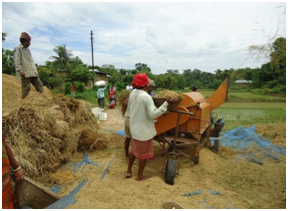 |
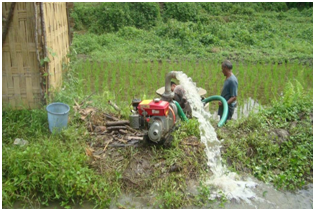 |
| Interventions on Custom Hiring Centre | |
HRD programmes in areas like Soil health management, Life saving irrigation, Cropping system, Protective cultivation, IPM, Soil moisture conservation, Livestock management, Life saving irrigation, Cropping system & Value addition were conducted covering 184 numbers of courses with 4375 numbers of farmers (Male: 2384 & Female: 1991). Different extension activities such as Method demonstrations, Agro advisory services, Awareness, Exposure visits, Group discussion, Diagnostic visit, Kishan gosthi, Farmers scientist interaction & Group meeting with VLMC of the village etc were also conducted in NICRA villages benefiting and 4708 number of farmers (Male: 2912 & Female: 1796) through 451 no of programmes.
 |
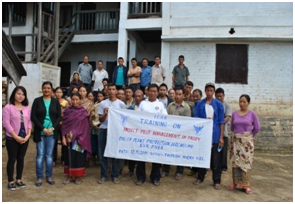 |
| Training programme | Training on IPM in cabbage |

